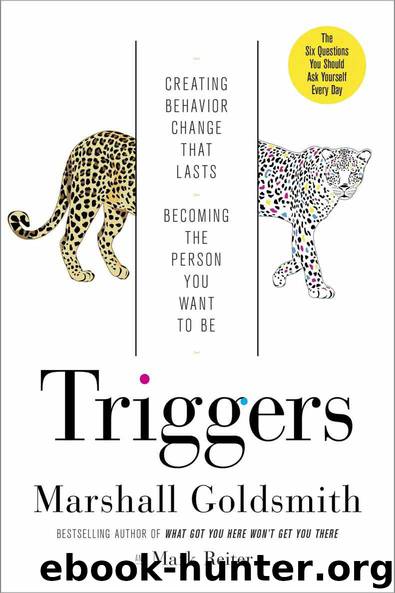Triggers: Creating Behavior That Lasts--Becoming the Person You Want to Be by Marshall Goldsmith & Mark Reiter

Author:Marshall Goldsmith & Mark Reiter [Goldsmith, Marshall]
Language: eng
Format: epub, mobi, azw
ISBN: 9780804141239
Publisher: The Crown Publishing Group
Published: 2015-05-18T22:00:00+00:00
Answering the first question is at the core of my professional life. After that meeting, I significantly increased my exhortations to companies on the importance of follow-up after they train their employees. It’s one of my signature themes: People don’t get better without follow-up. So let’s get better at following up with our people.
Putting Active Questions to the Test
My daughter made me realize that I was still too focused on the company. The fact that I was wondering who hired these people and who put them in the front lines of customer service was a good indicator that I was still holding the employer, not the employee, solely responsible for creating engaged workers. By stressing better follow-up, I was merely increasing the company’s burden, asking them to be more thorough in documenting their employees’ failures.
There was nothing wrong with my message, but I was ignoring half of the equation: the employee’s responsibility for his or her behavior. The difference was not what the company was doing to engage the flight attendants. The difference was what the flight attendants were doing to engage themselves!
This was such a breakthrough for me that I initiated a controlled study with Kelly to test the effectiveness of active questions with employees who undergo training. The theory was that different phrasing of the follow-up questions would have a measurable effect because active questions focus respondents on what they can do to make a positive difference in the world rather than what the world can do to make a positive difference for them. (John F. Kennedy must have known this when he crafted one of the more memorable calls to action in American history: “Ask not what your country can do for you, ask what you can do for your country.”)
In the first study, we used three different groups. The first group was a control group that received no training and was asked “before and after” questions on happiness, meaning, building positive relationships, and engagement.
The second group went to a two-hour training session about “engaging yourself” at work and home. This training was followed up every day (for ten working days) with passive questions:
1. How happy were you today?
2. How meaningful was your day?
3. How positive were your relationships with people?
4. How engaged were you?
Download
Triggers: Creating Behavior That Lasts--Becoming the Person You Want to Be by Marshall Goldsmith & Mark Reiter.mobi
Triggers: Creating Behavior That Lasts--Becoming the Person You Want to Be by Marshall Goldsmith & Mark Reiter.azw
This site does not store any files on its server. We only index and link to content provided by other sites. Please contact the content providers to delete copyright contents if any and email us, we'll remove relevant links or contents immediately.
Hit Refresh by Satya Nadella(9038)
The Compound Effect by Darren Hardy(8808)
Change Your Questions, Change Your Life by Marilee Adams(7635)
Nudge - Improving Decisions about Health, Wealth, and Happiness by Thaler Sunstein(7615)
The Black Swan by Nassim Nicholas Taleb(7010)
Deep Work by Cal Newport(6878)
Daring Greatly by Brene Brown(6444)
Rich Dad Poor Dad by Robert T. Kiyosaki(6401)
Principles: Life and Work by Ray Dalio(6208)
Man-made Catastrophes and Risk Information Concealment by Dmitry Chernov & Didier Sornette(5921)
Playing to Win_ How Strategy Really Works by A.G. Lafley & Roger L. Martin(5916)
Digital Minimalism by Cal Newport;(5663)
Big Magic: Creative Living Beyond Fear by Elizabeth Gilbert(5610)
The Myth of the Strong Leader by Archie Brown(5424)
The Slight Edge by Jeff Olson(5346)
Discipline Equals Freedom by Jocko Willink(5284)
The Motivation Myth by Jeff Haden(5156)
Stone's Rules by Roger Stone(5026)
The Laws of Human Nature by Robert Greene(4996)
